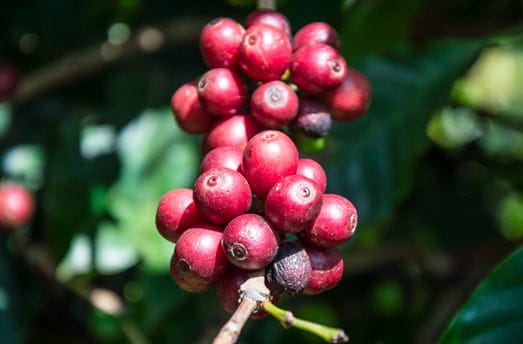Coffee Beans 101: Every Little Thing You Need to Understand About Espresso and Blended Coffee Beans
When it involves coffee, comprehending the subtleties of coffee and mixed beans can change your daily mug. You'll discover the distinctive attributes of Arabica and Robusta beans, and just how each effects taste and caffeine web content. From the growing procedure to toasting techniques, every step plays a function in your coffee experience. So, what makes the ideal mixture? Let's discover the important components that add to an extraordinary mug of coffee.
Comprehending Coffee Beans: Ranges and types
When diving into the world of coffee, understanding the kinds and selections of coffee beans is necessary for each enthusiast. You'll largely run into 2 major species: Arabica and Robusta. Arabica beans are recognized for their smooth, complicated flavors and reduced caffeine web content, making them a preferred among coffee aficionados. On the various other hand, Robusta beans load a punch with a more powerful, a lot more bitter preference and higher caffeine levels, often used in coffee blends.Within these species, you'll discover different local selections, each bringing unique attributes. For circumstances, Ethiopian Yirgacheffe supplies bright floral notes, while Colombian beans supply a well-balanced flavor profile. As you explore, remember to take notice of processing approaches like cleaned or natural, as they can greatly affect the last taste. By familiarizing on your own with these beans and their tastes, you'll raise your coffee experience and make even more educated selections in your brewing trip.
The Expanding Process: From Seed to Bean

It all begins with seed option techniques that establish the structure for quality when you check out the trip of coffee. From there, growing and collecting play necessary duties in ensuring the beans grow. Lastly, processing techniques transform those collected cherries right into the coffee beans you enjoy.
Seed Option Methods
Picking the appropriate seeds is important for creating high-grade coffee beans, as it lays the foundation for the entire growing process. You should begin by choosing seeds from trusted resources that prioritize top quality and hereditary diversity. Look for varieties known to grow in your certain climate and soil conditions. Take notice of the seed's age and storage problems, as fresh seeds often tend to germinate far better. When possible, select natural seeds to minimize direct exposure to damaging chemicals. Take into consideration the condition resistance of various varieties, as this can significantly impact your return. Don't hesitate to consult with regional farmers or experts to obtain understandings into the ideal seed choices for your region. This understanding will certainly enhance your coffee-growing experience.
Farming and Harvesting
As you nurture your coffee seeds into prospering plants, understanding the growing and harvesting process is vital for achieving the most effective flavor and quality. Single Origin Espresso. Start by growing your seeds in well-draining dirt, preferably in a shaded location to protect them from straight sunshine. As your plants expand, keep constant moisture, and bear in mind their requirement for nutrients. Prune consistently to advertise air flow and healthy and balanced growth.When it comes time to harvest, look for ripe cherries, which typically turn a lively red. Hand-picking is typically the best method to assure just the ripest cherries are picked. Timing is essential; gathering prematurely or far too late can impact the flavor profile of your beans. Welcome persistence and treatment, as this is where quality begins
Handling Techniques Discussed
The next vital step is refining them to change those vivid fruits right into the beans you'll make once you've harvested your coffee cherries. There are two major techniques: the dry procedure and the wet process. In the dry process, you spread the cherries out in the sunlight to dry, permitting the fruit to ferment and impart unique tastes to the beans. On the various other hand, the damp process includes removing the fruit right away and fermenting the beans in water, leading to a cleaner preference. After handling, the beans are hulled, sorted, and normally dried out again. Each approach impacts the flavor account, so try out both can help you find your favored mixture. Understanding these approaches is key to enjoying your coffee experience.
Toasting Techniques: Exactly How Taste Is Created
When it concerns roasting coffee beans, recognizing roast levels is essential to exposing their distinct tastes. Each roasting strategy effects the aroma and improves the flavor growth process, giving you a richer coffee experience. Let's discover just how these variables integrated to boost your daily brew.
Roast Degrees Explained
Roast degrees play a crucial function fit the taste profile of your coffee. When you pick a light roast, you'll delight in bright acidity and fruity notes. As you transfer to a tool roast, you'll see an equilibrium of sweetness and complexity, commonly highlighting chocolate or sugar flavors. Dark roasts, on the various other hand, deliver bold, great smoky qualities with less acidity, making them rich and durable. Each level results from various roasting times and temperature levels, influencing the beans' chemical composition. By understanding these degrees, you can better select a coffee that matches your taste preferences. Experiment with different roasts to find which one reverberates with you, improving your total coffee experience and satisfaction.

Effect on Scent
The roast level not only influences the preference of your coffee however additionally substantially impacts its scent. When you pick a light roast, you'll typically discover intense, floral notes that can make your coffee scent vivid and fresh. As the beans darken, the scent changes; a tool roast brings out extra well balanced, caramelized scents, while a dark roast has a tendency to feature strong, great smoky touches. Each roasting technique launches different volatile compounds, shaping how your coffee smells. In addition, the freshness of the beans plays an essential role; freshly roasted coffee launches more aromatic oils, boosting that luring fragrance. So, take notice of the roast degree-- it's key to exposing the full fragrant experience of your brew.
Taste Advancement Refine
As you check out the taste development procedure, you'll find that roasting techniques play a crucial duty in forming the taste account of your coffee. The roasting temperature and time straight influence the level of acidity, sweet taste, and anger of the beans. Light roasts keep even more of the bean's initial flavors, highlighting fruity and flower notes. Tool roasts equilibrium level of acidity and body, supplying a well-rounded flavor. Dark roasts, on the various other hand, draw out strong, great smoky features while reducing the bean's intrinsic top qualities. Throughout toasting, chemical reactions, like the Maillard reaction and caramelization, transform the beans and improve their intricacy. Trying out various roasting levels can aid you discover your ideal mixture, so don't be reluctant to taste and discover the abundant spectrum of flavors!
Coffee vs. Blended Coffee: Secret Distinctions
Coffee and blended coffee each deal distinct experiences that deal with different tastes and preferences. Coffee is a focused coffee made by requiring hot water through finely-ground coffee beans, leading to a rich, bold flavor and a luscious layer of crema ahead. It's often appreciated as a shot or made use of as a base for beverages like cappucinos and cappuccinos.On the various other hand, combined coffee combines different beans from various areas, producing a much more balanced flavor profile. You'll commonly find blends that highlight level of acidity, body, or sweet taste, making them flexible for different developing methods. While coffee concentrates on strength, mixed coffee may supply a more comprehensive variety of flavors that can transform with each sip.Ultimately, your selection between espresso and combined coffee come down to your individual choice. Whether you yearn for a fast shock or a leisurely mug, both alternatives have something delicious to use.
Brewing Approaches: Unlocking the Perfect Mug
Discovering the right method can transform your experience and raise your cup when it comes to developing coffee. Each developing method has its distinct charm and can considerably influence your coffee's taste and scent. Using a French press enables you to take pleasure in a rich and full-bodied brew, while a pour-over method gives a tidy, bright mug with unique flavors.If you favor espresso, investing in a top quality device can assist you understand the art of pulling shots. For convenience, a single-serve shuck system provides rate without giving up taste.Don' t fail to remember about cold brew, which provides a smooth, much less acidic coffee perfect for warm days. Try out different techniques to uncover what reverberates with your palate. Each brewing technique opens up a new world of possibilities, so make the effort to check out and find your perfect cup. Happy brewing!
Sampling Notes: Recognizing Taste Profiles
How can you really appreciate your coffee if you don't know what flavors to look for? Tasting notes are your guide to comprehending the complex top article globe of coffee. When you drink, focus on the preliminary flavors that hit your palate. You might identify fruity notes, like berry or citrus, or probably a nutty undertone. As you continue to taste, observe exactly how the flavors progress-- this is called the "finish." Some coffees might leave a chocolatey or caramel aftertaste, while others may have a brilliant, clean finish.Consider the find out here body of the coffee, too; is it light and airy or thick and syrupy? Do not fail to remember level of acidity; a brilliant level of acidity can add liveliness, while a low level of acidity may provide a smoother experience. By identifying these taste accounts, you'll strengthen your link with each mug, making coffee tasting a delightful trip of discovery.
Tips for Picking and Keeping Coffee Beans
Keeping and choosing coffee beans properly can substantially improve your brewing experience. Beginning by picking top quality beans that suit your preference. Try to find quality; beans roasted within the last two weeks are perfect. Examine the roast day on the packaging, and buy from reputable roasters or neighborhood shops.Once you have your beans, save them in an airtight container to avoid exposure to air, wetness, and light. A dark, cool place works best, so prevent keeping them in the fridge or fridge freezer, as this can introduce dampness. Only grind the amount you require to preserve quality; whole beans maintain flavor longer than pre-ground coffee.Lastly, attempt to use your beans within 2 to 4 weeks after opening for peak preference. Following these tips will certainly ensure your coffee remains flavorful and pleasurable, elevating your everyday mixture to brand-new heights.
Often Asked Questions
How Much Time Do Coffee Beans Remain Fresh After Toasting?
Coffee beans stay fresh for about two weeks after toasting. You need to keep them in a closed container, far from light and wetness. Afterwards, their flavor and fragrance start to decrease substantially.
Can I Mix Different Coffee Bean Varieties?
Absolutely, you can mix different coffee bean varieties! Try out blends can enhance tastes and produce an unique taste profile. Simply see to it to stabilize the strengths and characteristics of each variety for the very best results.
What Is the Suitable Work Size for Coffee?
:max_bytes(150000):strip_icc()/GettyImages-936840910-5c8ea8b2c9e77c0001ff0ae6.jpg)
Just How Does Elevation Affect Coffee Bean Taste?
Elevation impacts coffee bean taste by influencing the growth rate and chemical composition. Higher elevations lead to slower growth, which boosts level of acidity and intricacy, giving your coffee a lively and distinct preference you will not neglect.
Exist Decaffeinated Variations of Espresso Beans?
Yes, there are decaffeinated versions of coffee beans. You can take pleasure in an abundant coffee taste without the high levels of caffeine kick. Just look for "decaf" blends at your local coffee store or specialized store. Single Origin Espresso. When diving into the world of coffee, recognizing the types and varieties of coffee beans is essential for every enthusiast. When it comes to toasting coffee beans, comprehending roast degrees is vital to exposing their distinct flavors. Espresso is a concentrated coffee made by forcing warm water with finely-ground coffee beans, resulting in an abundant, strong taste and a luscious layer of crema on top. While espresso pop over to this web-site focuses on intensity, blended coffee might offer a more comprehensive variety of flavors that can change with each sip.Ultimately, your selection between coffee and blended coffee boils down to your personal preference. Some coffees might leave a chocolatey or sugar aftertaste, while others may have a brilliant, tidy finish.Consider the body of the coffee, too; is it light and airy or thick and syrupy?
 Jennifer Grey Then & Now!
Jennifer Grey Then & Now! Michael Jordan Then & Now!
Michael Jordan Then & Now! Talia Balsam Then & Now!
Talia Balsam Then & Now! Lacey Chabert Then & Now!
Lacey Chabert Then & Now! Nicki Minaj Then & Now!
Nicki Minaj Then & Now!